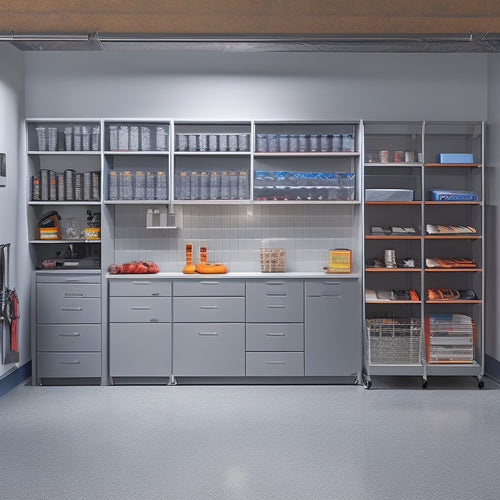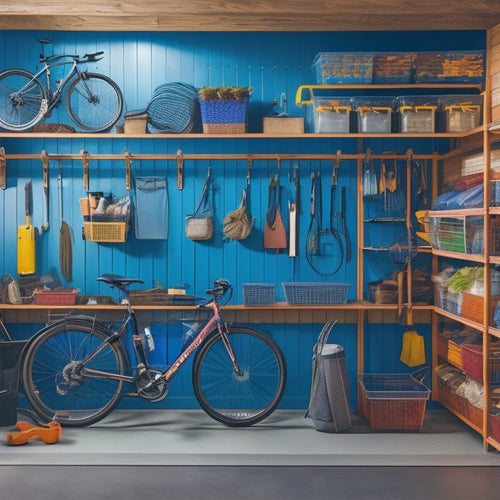
7 Simple Hacks to Boost Woodshop Efficiency
Share
You're wasting precious time in your woodshop due to inefficient workspace and workflow design. To boost efficiency, start by optimizing your workspace layout for maximum productivity, positioning frequently used tools within easy reach. Implement a tool organization system with clear labels and categorization. Next, identify and eliminate bottlenecks in your workflow, simplifying tasks and enhancing communication. Allocate specific time slots for tasks using time blocking, and prioritize to minimize distractions. You'll be surprised how these simple hacks can streamline your workflow. By addressing these key areas, you'll uncover even more opportunities to fine-tune your woodshop's productivity.
Key Takeaways
• Organize your workspace to minimize walking distances and maximize tool accessibility, reducing time wasted on unnecessary movement.
• Implement a tool organization system, categorizing and labeling tools to prevent mistakes and save time searching for misplaced items.
• Use time blocking to schedule tasks like cutting, sanding, and assembly, allocating specific time slots to prioritize efficiency and minimize distractions.
• Cut, sand, and assemble similar components in batches to reduce task-switching time and minimize interruptions, optimizing workflow sequencing.
• Position frequently used tools within easy reach, utilizing a color-coding system to quickly identify and access the tools you need.
Optimize Your Workspace Layout
Rearrange your woodshop's workspace to maximize productivity by grouping similar tools and tasks together, creating a logical workflow that saves you time and reduces fatigue.
This optimized layout is key to space utilization and ergonomic design, ensuring you can work comfortably and efficiently. By positioning frequently used tools within easy reach, you'll reduce walking distances and minimize bending or stretching. This thoughtful arrangement also helps prevent mistakes, as you'll be less likely to misplace tools or forget vital steps in your workflow.
To further boost workflow efficiency, identify productivity hacks that streamline your process. Consider the tasks you perform most often and design your workspace around them.
For instance, if you're constantly switching between a table saw and a drill press, place them adjacent to each other to minimize pivotal time. By fine-tuning your workspace layout, you'll be able to complete projects faster and with greater accuracy, allowing you to serve your clients more effectively.
Streamline Tool Organization Systems
Implement a tool organization system that assigns a designated home for each tool, making it easy to find what you need when you need it, and reducing downtime spent searching for misplaced items. This will save you time and energy, allowing you to focus on the project at hand.
Start by categorizing your tools into groups, such as hand tools, power tools, and measuring tools. Then, designate a specific area or container for each group. For instance, you can use a pegboard for hanging hand tools, a shelving unit for power tools, and a toolbox for measuring tools.
Label each container or area clearly, so you can quickly identify where each tool is stored. Consider using a color-coding system to differentiate between tool categories. This will help you maintain your organization system and make it easier to find what you need.
Effective tool storage is key to a well-organized woodshop. By implementing a thoughtful organization system, you'll be able to work more efficiently and complete projects faster.
Implement Efficient Workflows
To maximize your woodshop's productivity, you'll need to identify and eliminate bottlenecks in your workflow by analyzing how you move through tasks and projects. Take a closer look at your current workflow and pinpoint areas where tasks are slowing you down.
Once you've identified these bottlenecks, it's time to simplify task delegation. Assign tasks to team members based on their strengths and expertise, and guarantee they've the necessary resources to complete their tasks efficiently.
Enhance communication by implementing regular check-ins and progress updates. This will help you stay on top of projects and address any issues promptly. Consider implementing digital solutions, such as project management software, to streamline communication and task management.
Automate repetitive tasks where possible, freeing up more time for high-priority tasks. By implementing these changes, you'll be able to work smarter, not harder, and boost your woodshop's efficiency.
Master the Art of Time Blocking
By streamlining your workflow, you've set the stage for peak productivity, and now it's time to take it to the next level by allocating specific time slots for tasks, a technique known as time blocking. This time management hack helps you prioritize tasks, minimize distractions, and maximize your output. To get started, identify the tasks that require the most attention and allocate specific time slots for each task.
| Task | Time Slot |
|---|---|
| Cutting lumber | 9:00 am - 10:00 am |
| Sanding | 10:00 am - 11:30 am |
| Assembly | 1:00 pm - 3:00 pm |
Eliminate Wasted Movement Time
When you're working on a project, you're constantly moving between tools and workstations.
To eliminate wasted movement time, you need to optimize your tool placement and streamline your workstation layout.
Optimize Tool Placement
You likely spend more time than you think walking back and forth between tools and workpieces, which is why optimizing tool placement is essential to eliminating wasted movement time. By strategically positioning your tools, you can reduce the distance you need to travel and increase your productivity.
Here are some tips to optimize your tool arrangement:
-
Store frequently used tools in easy-to-reach locations: Keep your most-used tools in convenient spots, such as on a pegboard or in a nearby cabinet, to minimize walking distances.
-
Group similar tools together: Organize your tools by function or type, making it easier to find what you need quickly.
-
Prioritize tool accessibility: Consider the workflow of your projects and place tools in the order you'll need them, making it easier to shift between tasks.
Streamline Workstation Layout
Now that your tools are organized, turn your attention to the workstation itself, where a well-planned layout can save you even more time and energy. A streamlined workstation layout is all about minimizing movement and maximizing efficiency. Start by identifying the tasks you perform most frequently and positioning your equipment accordingly. This will guarantee that the tools you need are always within easy reach, reducing the time spent walking back and forth.
Optimize your space utilization by grouping similar tasks together and allocating sufficient space for each process. Consider the workflow efficiency of your station and arrange your tools in a logical sequence to minimize bottlenecks. For instance, place your measuring tools near your cutting equipment, and your sanding tools near your finishing area. By doing so, you'll reduce the time spent shifting between tasks and increase your overall productivity.
Leverage Vertical Storage Spaces
Maximize your woodshop's square footage by installing shelving units, cabinets, or pegboards that take advantage of often-wasted vertical space, keeping essential tools and supplies within easy reach. By utilizing vertical storage techniques, you'll free up valuable floor space, reduce clutter, and increase productivity. This will enable you to focus on serving others through your woodworking creations.
Here are some ways to leverage vertical storage spaces:
-
Install overhead storage racks for infrequently used items, such as seasonal decorations or special occasion supplies.
-
Use wall-mounted pegboards to hang frequently used tools, like hammers, saws, and drills, keeping them organized and easily accessible.
-
Incorporate floor-to-ceiling shelving units or cabinets to store materials, like lumber, pipes, or hardware, and keep them out of the way but still accessible.
Prioritize Task-Based Batch Processing
When you prioritize task-based batch processing in your woodshop, you'll notice a significant boost in efficiency. By grouping similar tasks together, you'll reduce the time spent on tool changeovers and optimize your workflow sequencing.
This approach will help you complete projects faster and with greater precision, so it's crucial to plan your tasks strategically and make the most of your time.
Plan Similar Tasks Together
By grouping similar tasks together, you can complete them in a single session, reducing setup and teardown times and increasing your overall woodshop efficiency. This task grouping approach, also known as project batching, allows you to focus on similar operations without switching between different tasks.
As a result, you'll make the most of your time and energy, producing high-quality work while minimizing waste.
Here are some ways to apply task grouping in your woodshop:
-
Cut all lumber for a project at once: Instead of cutting individual pieces as needed, cut all the required lumber in one session. This reduces the number of times you need to set up and calibrate your saw.
-
Sand all surfaces simultaneously: Group similar sanding tasks together, such as sanding all the surfaces that require the same grit sandpaper. This helps maintain a consistent finish and saves time.
-
Assemble similar components in batches: If you're building multiple identical components, assemble them in batches to reduce the time spent switching between tasks and tools.
Minimize Tool Changeovers Needed
To optimize your woodshop workflow, prioritize task-based batch processing to minimize tool changeovers needed, as this approach can reduce downtime and boost overall efficiency. By grouping similar tasks together, you'll spend less time switching between tools and more time getting actual work done.
This strategy also enables you to tackle tool maintenance in one go, ensuring your equipment is in top condition before moving on to the next task.
Proper tool storage is also pivotal in minimizing tool changeovers. Keep frequently used tools within easy reach, and label your storage bins to avoid wasting time searching for misplaced items. Consider color-coding your tools or using a pegboard to maximize storage space and keep your workshop organized.
Optimize Workflow Sequencing
You'll further maximize your woodshop's efficiency by sequencing tasks in a logical order, grouping similar operations together to minimize movement between workstations and reduce waste. This workflow optimization technique is all about prioritizing task-based batch processing to streamline your process efficiency. By doing so, you'll reduce the time spent on handoffs and increase the time spent on actual woodworking.
Here are some key considerations to keep in mind:
-
Identify bottlenecks: Pinpoint the tasks that take the longest or require the most resources, and schedule them first to avoid delays later on.
-
Sequence similar tasks: Group tasks that require similar tools or setups to minimize tool sequencing and changeovers.
-
Prioritize high-volume tasks: Focus on tasks that produce high volumes of output, ensuring you're making the most of your time and resources.
Frequently Asked Questions
How Do I Handle Woodworking Projects With Unusual or Custom Sizes?
When tackling woodworking projects with unusual or custom sizes, you'll need creative solutions for custom dimensions and innovative designs that incorporate unconventional materials, so think outside the box and get ready to problem-solve!
Can I Repurpose Old Furniture for Woodshop Storage and Organization?
"You breathe new life into old furniture, transforming it into functional DIY storage solutions. By upcycling, you'll create unique organizers that not only declutter your woodshop but also tell a story of creativity and resourcefulness."
Are There Any Safety Considerations for a Small Woodshop Space?
You must prioritize safety in your small woodshop space by implementing essential precautions, like clear walkways, well-maintained tools, and proper ventilation, to minimize hazards and guarantee a safe working environment despite space limitations.
How Often Should I Sharpen My Woodworking Tools for Optimal Performance?
You should sharpen your woodworking tools every 1-3 months, depending on usage, to maintain peak performance and extend tool longevity through regular maintenance, ensuring you get the best results from your tools.
Are There Any Benefits to Using a Woodshop Project Management Software?
"You're the master conductor of your woodshop orchestra, harmonizing tools and tasks. With project management software, you'll expertly balance budget tracking and time management, ensuring your symphony of woodwork flows smoothly, and your creations resonate with precision and pride."
Related Posts
-

Adjustable Modular Shoe Racks for Versatility
Adjustable modular shoe racks are your go-to solution for versatile and organized footwear storage. These racks maxim...
-

Building a Garage Storage System With Built-Ins
You're about to build a garage storage system with built-ins that fits your unique needs, starting by evaluating your...
-

Garage Wall Storage Ideas to Boost Productivity
You can enhance your garage's productivity by capitalizing on your ceiling height with overhead racks, storing bulky ...


